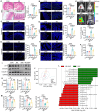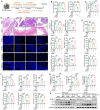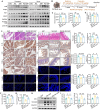Neferine Ameliorates Severe Acute Pancreatitis-Associated Intestinal Injury by Promoting NRF2-mediated Ferroptosis
- PMID: 40384872
- PMCID: PMC12080392
- DOI: 10.7150/ijbs.112888
Neferine Ameliorates Severe Acute Pancreatitis-Associated Intestinal Injury by Promoting NRF2-mediated Ferroptosis
Abstract
Severe acute pancreatitis (SAP) is a life-threatening abdominal condition often complicated by intestinal barrier dysfunction, which further exacerbates disease progression. Neferine has demonstrated potent anti-inflammatory and antioxidant properties; however, its role in ameliorating SAP and associated intestinal barrier damage remains unclear. In this study, we found that neferine administration significantly alleviates SAP severity by reducing pancreatic and ileal pathological damage, oxidative stress, inflammatory cell infiltration, and intestinal flora translocation. Additionally, neferine enhances the expression of tight junction proteins, increases short-chain fatty acid levels, and improves intestinal dysbiosis, thereby contributing to intestinal homeostasis restoration. Mechanistically, neferine upregulates Nrf2 expression and promotes its nuclear translocation by competitively binding to the Cys-288 site on Keap1. This activation enhances the Nrf2/FPN and Nrf2/xCT/GPX4 axes, thereby preventing ferroptosis and ultimately protecting against pancreatic and intestinal injury in SAP mice. Furthermore, the protective effects of neferine were largely reversed by the Nrf2 inhibitor ML385 and the ferroptosis inducer erastin. This study demonstrates that neferine effectively alleviates SAP by inhibiting ferroptosis and restoring intestinal homeostasis, providing insights into new treatment options for SAP.
Keywords: Acute pancreatitis; Ferroptosis; Gut microbiota; Intestinal injury; Iron export; Neferine.
© The author(s).
Conflict of interest statement
Competing Interests: The authors have declared that no competing interest exists.
Figures








Similar articles
-
Emodin protects against severe acute pancreatitis-associated acute lung injury by activating Nrf2/HO-1/GPX4 signal and inhibiting ferroptosis in vivo and in vitro.BMC Gastroenterol. 2025 Feb 5;25(1):57. doi: 10.1186/s12876-025-03660-1. BMC Gastroenterol. 2025. PMID: 39910464 Free PMC article.
-
Ganoderic Acid A Alleviates Severe Acute Pancreatitis by Modulating Gut Homeostasis and Inhibiting TLR4-NLRP3 Signaling.J Agric Food Chem. 2025 Jan 15;73(2):1563-1579. doi: 10.1021/acs.jafc.4c07635. Epub 2024 Dec 31. J Agric Food Chem. 2025. PMID: 39811933
-
Glycyrrhizin Ameliorates Cardiac Injury in Rats with Severe Acute Pancreatitis by Inhibiting Ferroptosis via the Keap1/Nrf2/HO-1 Pathway.Dig Dis Sci. 2024 Jul;69(7):2477-2487. doi: 10.1007/s10620-024-08398-6. Epub 2024 May 16. Dig Dis Sci. 2024. PMID: 38753240
-
Nrf2 alleviates acute ischemic stroke induced ferroptosis via regulating xCT/GPX4 pathway.Free Radic Biol Med. 2025 Apr;231:153-162. doi: 10.1016/j.freeradbiomed.2025.02.040. Epub 2025 Feb 26. Free Radic Biol Med. 2025. PMID: 40020881
-
Pretreatment with chitosan oligosaccharides attenuate experimental severe acute pancreatitis via inhibiting oxidative stress and modulating intestinal homeostasis.Acta Pharmacol Sin. 2021 Jun;42(6):942-953. doi: 10.1038/s41401-020-00581-5. Epub 2021 Jan 25. Acta Pharmacol Sin. 2021. PMID: 33495520 Free PMC article.
References
-
- Chaitoff A, Cifu AS, Niforatos JD. Initial Management of Acute Pancreatitis. Jama. 2020;323:2331–2. - PubMed
-
- Sendler M, van den Brandt C, Glaubitz J, Wilden A, Golchert J, Weiss FU. et al. NLRP3 Inflammasome Regulates Development of Systemic Inflammatory Response and Compensatory Anti-Inflammatory Response Syndromes in Mice With Acute Pancreatitis. Gastroenterology. 2020;158:253–69.e14. - PubMed
-
- Beger HG, Rau B, Mayer J, Pralle U. Natural course of acute pancreatitis. World J Surg. 1997;21:130–5. - PubMed
-
- Cui QR, Ling YH, Wen SH, Liu KX, Xiang YK, Yang WJ. et al. Gut Barrier Dysfunction Induced by Aggressive Fluid Resuscitation in Severe Acute Pancreatitis is Alleviated by Necroptosis Inhibition in Rats. Shock. 2019;52:e107–e16. - PubMed
MeSH terms
Substances
LinkOut - more resources
Full Text Sources
Medical
Miscellaneous

